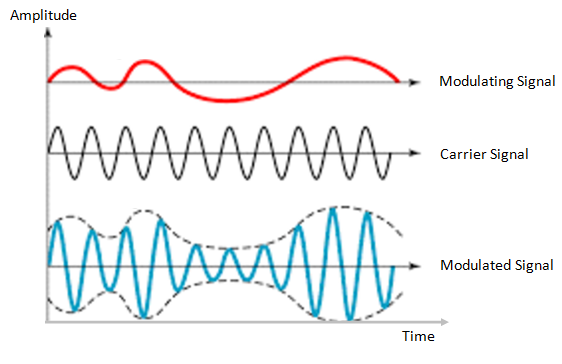Amplitude Modulation:
Amplitude modulation or AM as it is often called, is a form of modulation used for radio transmissions for broadcasting and two way radio communication applications.
Although one of the earliest used forms of modulation it is still used today, mainly for long, medium and short wave broadcasting and for some aeronautical point to point communications.
Amplitude modulation history:
The first amplitude modulated signal was transmitted in 1901 by a Canadian engineer named Reginald Fessenden. He took a continuous spark transmission and placed a carbon microphone in the antenna lead.
The sound waves impacting on the microphone varied its resistance and in turn this varied the intensity of the transmission. Although very crude, signals were audible over a distance of a few hundred metres, although there was a rasping sound caused by the spark.
With the introduction of continuous sine wave signals, transmissions improved significantly, and AM soon became the standard for voice transmissions. Nowadays, amplitude modulation, AM is used for audio broadcasting on the long medium and short wave bands, and for two-way radio communication at VHF for aircraft.
However as there now are more efficient and convenient methods of modulating a signal, its use is declining, although it will still be very many years before it is no longer used.
What is amplitude modulation?
In order that a radio signal can carry audio or other information for broadcasting or for two way radio communication, it must be modulated or changed in some way. Although there are a number of ways in which a radio signal may be modulated, one of the easiest is to change its amplitude in line with variations of the sound.
In this way the amplitude of the radio frequency signal varies in line with the instantaneous value of the intensity of the modulation. This means that the radio frequency signal has a representation of the sound wave superimposed in it.
In view of the way the basic signal “carries” the sound or modulation, the radio frequency signal is often termed the “carrier”.

From the diagram, it can be seen that the envelope of the signal follows the contours of the modulating signal.
Amplitude demodulation:
Amplitude modulation, AM, is one of the most straightforward ways of modulating a radio signal or carrier. It can be achieved in a number of ways, but the simplest uses a single diode rectifier circuit.
Other methods of demodulating an AM signal use synchronous techniques and provide much lower levels of distortion and improved reception where selective fading is present.
One of the main reasons for the popularity of amplitude modulation has been the simplicity of the demodulation. It enables costs to be kept low – a significant advantage in producing vast quantities of very low-cost AM radios.
Advantages of Amplitude Modulation:
There are several advantages of amplitude modulation, and some of these reasons have meant that it is still in widespread use today:
- It is simple to implement
- it can be demodulated using a circuit consisting of very few components
- AM receivers are very cheap as no specialised components are needed.

Disadvantages of amplitude modulation:
Amplitude modulation is a very basic form of modulation, and although its simplicity is one of its major advantages, other more sophisticated systems provide a number of advantages. Accordingly it is worth looking at some of the disadvantages of amplitude modulation.
- It is not efficient in terms of its power usage
- It is not efficient in terms of its use of bandwidth, requiring a bandwidth equal to twice that of the highest audio frequency
- It is prone to high levels of noise because most noise is amplitude based and obviously AM detectors are sensitive to it.
Derivatives of Amplitude Modulation:
Although the use of amplitude modulation is decreasing, it nevertheless forms the basis of other forms of modulation that are still being widely used, or their use is increasing.
- Single sideband, SSB: Single sideband is widely used for HF communications. It is formed by taking a signal that has the carrier and one sideband removed. In this way it becomes far more efficient in terms of both spectrum and power. Read more about Single Sideband, SSB
- Quadrature amplitude modulation, QAM: This form of modulation is essentially derived from two carriers that are 90° out of phase and adding information, either analogue or digital. Quadrature Amplitude Modulation is widely used for carrying many digital signals, everything from Wi-Fi to Mobile phone communications and very much more.
AM overview:
AM has advantages of simplicity, but it is not the most efficient mode to use, both in terms of the amount of space or spectrum it takes up, and the way in which it uses the power that is transmitted. This is the reason why it is not widely used these days both for broadcasting and for two-way radio communication.
Even the long, medium and short -wave broadcasts will ultimately change because of the fact that amplitude modulation, AM, is subject to much higher levels of noise than are other modes.
For the moment, its simplicity, and its widespread usage, mean that it will be difficult to change quickly, and it will be in use for many years to come.
